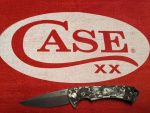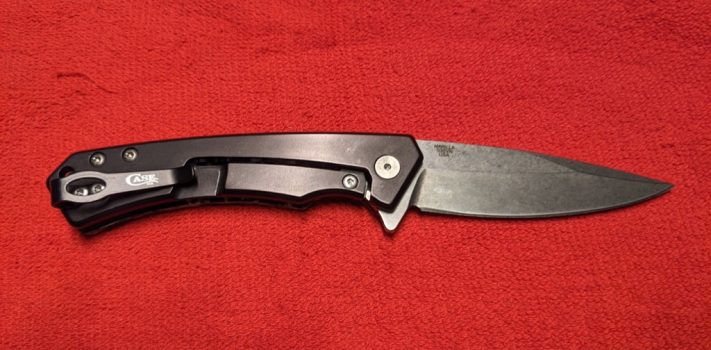With a razor-sharp, 3.5-inch, drop-point blade made of satin-stonewash-finished S35VN steel; a carbon-fiber and aluminum handle with a frame-lock; a one-handed, ambidextrous flipper for deployment; and a reversible, deep-carry, steel pocket clip, the Case Marilla Folding Knife represents an outstanding example of a modern everyday carry (EDC) knife that is made by an iconic American company.
With a price at the time of this writing of $207.99 a the caseknives.com website, the Marilla is neither the cheapest nor the most expensive EDC knife on the market. But as a well-crafted, American-made knife built of high-quality materials, the Marilla represents a good value for the money. It has earned a place as a “keeper” with a small number of other EDC knives in my life.
Background
W.R. Case & Sons Cutlery Company is probably best known as a maker of widely-collected traditional pocket knives. So when I found out that Case had added a modern EDC knife to their product line, I was very interested.
There are three major features that in my opinion differentiate a modern EDC knife from a traditional pocket knife:
- The modern EDC knife uses a locking mechanism rather than a slip joint to hold the folding blade open.
- The modern EDC knife has some sort of provision to enable one-handed deployment of the blade.
- The modern EDC knife has a pocket clip.
I contacted Case to see if they could provide me with a sample of their new Marilla knife for testing and evaluation. They were kind enough to agree. Less than a week later, a box was delivered to my door via UPS Ground.
First Impressions
 I was surprised to see that the box was shipped from Zippo Manufacturing. I did not know that there was a connection between Zippo and Case. As it happened, W.R. Case & Sons Cutlery Company moved to Bradford, Pennsylvania from western New York in 1905. By coincidence, Mr. George Blaisedell, also of Bradford, Pennsylvania, designed the Zippo lighter and founded his own company there in the 1930s. Eventually, the newer Bradford company acquired the older one.
I was surprised to see that the box was shipped from Zippo Manufacturing. I did not know that there was a connection between Zippo and Case. As it happened, W.R. Case & Sons Cutlery Company moved to Bradford, Pennsylvania from western New York in 1905. By coincidence, Mr. George Blaisedell, also of Bradford, Pennsylvania, designed the Zippo lighter and founded his own company there in the 1930s. Eventually, the newer Bradford company acquired the older one.
The shipping box contained the package box for the knife along with a baseball cap and a golf towel. The cap and the towel were each emblazoned with the Case logo.
The nicer-than-average package box informed me that the knife is “Made in the USA with Domestic and Imported materials.”
 The particular version of the Marilla that I received has a handle made of black and white carbon fiber on the one side. The other side of the handle is made of black anodized aluminum. The Marilla is also available in 2 other color versions with carbon-fiber/anodized-aluminum handles, 2 color versions with both sides of the handle made of anodized aluminum, and 5 color versions with G-10/anodized-aluminum handles.
The particular version of the Marilla that I received has a handle made of black and white carbon fiber on the one side. The other side of the handle is made of black anodized aluminum. The Marilla is also available in 2 other color versions with carbon-fiber/anodized-aluminum handles, 2 color versions with both sides of the handle made of anodized aluminum, and 5 color versions with G-10/anodized-aluminum handles.
 Because of its carbon-fiber and aluminum construction, the sample I tested exhibits an outstanding strength-to-weight ratio. The knife weighs a total of only 3.6 ounces. The blade and handle are nicely balanced. The pocket clip appears to be very sturdy. The flipper does an outstanding job of deploying the blade around the ball bearing pivot point. The knife does require a somewhat deliberate and vigorous flick of the flipper for the frame lock to fully engage. As the knife broke in over a month of regular use, it steadily became more forgiving of more distracted and sluggish attempts to deploy the blade.
Because of its carbon-fiber and aluminum construction, the sample I tested exhibits an outstanding strength-to-weight ratio. The knife weighs a total of only 3.6 ounces. The blade and handle are nicely balanced. The pocket clip appears to be very sturdy. The flipper does an outstanding job of deploying the blade around the ball bearing pivot point. The knife does require a somewhat deliberate and vigorous flick of the flipper for the frame lock to fully engage. As the knife broke in over a month of regular use, it steadily became more forgiving of more distracted and sluggish attempts to deploy the blade.
The high-quality S35VN blade was very nicely shaving sharp right out of the box. I ended up shaving a significantly larger patch of hair from my left forearm than I intended while testing this sharpness. The blade also displayed excellent edge retention throughout the testing period.
The jimping on the back of the blade is shallower than that which is found on many knives. It also extends further along the back of the blade. Both of these design decisions seem to be well-founded, since the shallower jimping seems to function just as effectively as deeper jimping for blade control, while the additional extension along the back of the blade seems to provide added control during delicate cuts.
The stonewashed finish on the blade is attractive and practical. The blade is approximately 0.13 inches thick at its base.
Testing
I carried the Marilla daily for a month, and used it for the boring tasks of daily life:
Opening a box of 6.5 Creedmoor ammunition from Rivertown Munitions in Schippenville, Pennsylvania. By the way, this was my first purchase from that company, and I was very pleased. The price was better than I could obtain locally, and the order arrived very quickly.
puncturing a crock pot liner bag to allow meat juice to flow into a frying pan so that my wife, “Kari”, could make gravy from the juice.
using the tip of the knife to push an Allen wrench back into a blister pack of scope rings so the wrench could be stored until the next time I needed it.
opening the packaging on a new ditch bank blade.
cutting open a 50-pound bag of dog food so that I could transfer the contents to storage containers.
opening a shipping box containing extra elements for our water filter so that we could keep them on hand until we need them.
opening a package containing Atlas Mike’s Lunker Oil, Earthworm Scent for fishing with my grandkids.
opening letters and bills.
opening a package of string cheese so that I could eat a couple of sticks of it.
cutting open a 25-pound bag of Jasmine rice so that I could transfer its contents to storage containers.
cutting open a package of flags for our missionary display at church.
cutting a piece of twine to use to suspend ditch bank blades below a fishing scale to see how much they weigh.
cutting plastic worms into hook-sized segments before soaking them in the aforementioned Atlas Mike’s Lunker Oil.
stripping insulation from a broken wire on a trailer wiring harness so that the wire could be repaired.
modifying the desk pen in my office so that it can accommodate Parker refills instead of Cross gel refills. This involved cutting a piece of plastic tube to fill the space left by the shorter Parker refills.
cutting folded paper while working on various craft projects with the grandkids.
A “Keeper”
I test many knives while researching articles for SurvivalBlog. Following testing, most of those knives end up in the “knife box” in my basement. From there, I give them away to friends, family members, and acquaintances who can put them to good use.
A literal handful of the EDC knives that I test achieve “keeper” status. These are the knives that attain a permanent place in my pocket, glove compartment, peg board, or tackle box. When a knife achieves keeper status, it displaces another knife which is then relegated to the knife box.
The Marilla has achieved keeper status, earning a place in the mini survival kit that I keep in the glove compartment of my car. It is now one of “the few, the proud, the keepers”.
S35VN Steel
 CPM S35VN is a high-end stainless steel consisting of 79.1% iron, 14% chromium, 3% vanadium, 2% molybdenum, 1.4% carbon, and 0.5% niobium. It is manufactured in the United States by Crucible Industries using their Crucible Particle Metallurgy (CPM) process. This process involves pouring the molten metal through a tiny nozzle and exposing the liquid stream to a burst of high-pressure gas which scatters the metal into a host of tiny particles. The particles are then fused together under great heat and pressure under vacuum conditions to form a highly homogeneous and fine-grained microstructure. S35VN offers excellent corrosion resistance, edge retention, and wear resistance.
CPM S35VN is a high-end stainless steel consisting of 79.1% iron, 14% chromium, 3% vanadium, 2% molybdenum, 1.4% carbon, and 0.5% niobium. It is manufactured in the United States by Crucible Industries using their Crucible Particle Metallurgy (CPM) process. This process involves pouring the molten metal through a tiny nozzle and exposing the liquid stream to a burst of high-pressure gas which scatters the metal into a host of tiny particles. The particles are then fused together under great heat and pressure under vacuum conditions to form a highly homogeneous and fine-grained microstructure. S35VN offers excellent corrosion resistance, edge retention, and wear resistance.
W.R. Case & Sons Cutlery Company
The protohistory of W.R. Case and Sons Cutlery Company stretches back to 1889, when the 4 Case brothers began selling hand-crafted cutlery from a wagon in rural western New York.
One of the Case brothers, William Russell Case, eventually helped his son, John Russell Case, to form his own cutlery company. John Russell named the new company W.R. Case & Sons Cutlery Company in honor of his father.
Soon after the company was formed, it moved its headquarters from western New York to Bradford, Pennsylvania in 1905.
During the First and Second World Wars, Case also manufactured knives for the U.S. military, most notably the M3 Fighting Knife. Case manufactured 300,465 of the M3 knives in 1943 and 1944.
Conclusions
The Case Marilla Folding Knife is an outstanding, American-made, EDC knife. Its carbon fiber and aluminum handle give it an excellent strength-to-weight ratio, and the S35VN blade takes and holds an edge extremely well.
If you are looking for a well-crafted knife made of high-quality materials, this one would be a good choice.
Disclaimer
W.R. Case & Sons Cutlery Company was kind enough to provide me with a sample of their Marilla folding knife for testing and evaluation. I tried not to allow their kindness to interfere with the objectivity of my review, and I believe that I have succeeded. I did not receive any other financial or other inducement to mention any vendor, product, or service in this article.










